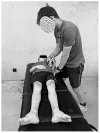Reference Values and Construct Validity for 4 Upper Limb Physical Performance Tests in Junior Tennis Players
- PMID: 39972277
- PMCID: PMC11840830
- DOI: 10.1177/19417381251320097
Reference Values and Construct Validity for 4 Upper Limb Physical Performance Tests in Junior Tennis Players
Abstract
Background: Upper extremity physical-performance-tests are gaining interest for screening overhead athletes in view of injury prevention, individual performance, and return to play after injury. However, at present, no reference data are available for these tests in a junior tennis population. In addition, the construct validity of these tests with respect to shoulder strength is still unclear.
Hypothesis: Junior tennis players will exhibit differences in test performance based on age, sex, and side. Shoulder strength will be moderately to highly correlated with the seated medicine ball throw (SMBT) and the modified-closed-kinetic-chain-upper-extremity test (M-CKCUEST), but not with shoulder endurance test (SET) and the Y-balance-test-upper-quadrant (YBT-UQ).
Study design: Descriptive study, cross-sectional design.
Level of evidence: Level 3.
Methods: Four commonly used physical performance tests (PPTs) (YBT-UQ, M-CKCUEST, SMBT, and SET) were executed by 99 junior tennis players aged 9 to 18 years. In addition, isometric external and internal rotation strength was measured, using a hand-held dynamometer. Descriptive reference values were reported, and correlations between the PPTs and strength values were calculated.
Results: A linear regression model with backwards stepwise regression was used to identify possible age, sex, and side differences regarding PPTs and strength. Some, but not all reached statistical significance. Moderate-to-high correlations (Pearson correlation coefficients) were found between the M-CKCUEST, SMBT, and SET and strength measurements, establishing acceptable construct validity with respect to strength. No significant correlation was found between the YBT-UQ and strength.
Conclusion: Junior tennis players exhibit differences in test performance based on age, sex, and side. The MCKCUEST, SMBT, and SET may be valuable alternatives for strength testing in the clinical setting.
Clinical relevance: These tests may provide a valuable, user-friendly alternative for strength measurements in junior tennis players.
Keywords: prevention; return-to-sport; screening; tennis; upper limb physical performance test.
Conflict of interest statement
The authors report no potential conflicts of interest in the development and publication of this article.
Figures






References
-
- Abrams GD, Renstrom PA, Safran MR. Epidemiology of musculoskeletal injury in the tennis player. Br J Sports Med. 2012;46(7):492-498. - PubMed
-
- Ardern CL, Glasgow P, Schneiders A, et al.. 2016 Consensus statement on return to sport from the First World Congress in Sports Physical Therapy, Bern. Br J Sports Med. 2016;50(14):853-864. - PubMed
-
- Barbosa GM, Ribeiro LP, Nasser AB, Oliver GD, Camargo PR. Flexibility, position, and strength of the shoulder complex in pediatric and adult amateur tennis athletes. J Sport Rehab. 2022;31(1):1-9. - PubMed
-
- Borg GA. Psychophysical bases of perceived exertion. Med Sports Sci Exc. 1982;14(5):377-381. - PubMed
LinkOut - more resources
Full Text Sources
Research Materials

